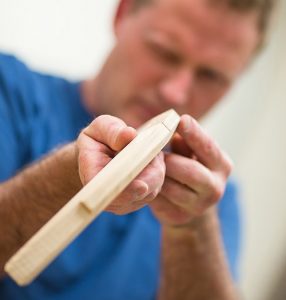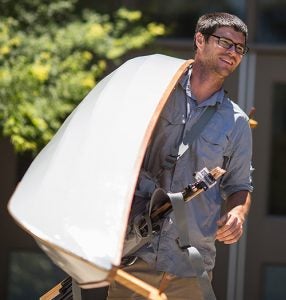MAIDEN VOYAGE
First ECU boatbuilding class launches handcrafted canoes on Tar River
It was a shorter paddle than expected but still a success for East Carolina University boatbuilding student Grace Joyner and her classmates.
After five weeks of painstaking work, Joyner’s final exam was to launch her skin-on-frame canoe June 20 on the Tar River. Although the hull took on water, School of Art and Design instructor Gerald Weckesser said all nine students passed.
“It’s a rousing success; this is a victory,” Weckesser said. “We’ll take them back, dry them out, re-coat them and do it again. I’m pretty confident with a little tune up, we’ll have some completely floating vessels.” Another coat or two of polyurethane would help prevent any seepage.
“I thought it was a lot of fun,” said student Abby Barringer, a senior ceramics and photography major from Harrisburg. “I had to make the voyage. After five weeks of work, you have to do it.”
Before the launch, students added some final pieces – stress bands, floor boards and rub rails – then carried their boats from the Jenkins Fine Arts Building to the Town Common access. The boats weigh about 15 pounds, so they’re easily transportable, Weckesser said.

Gerald Weckesser checks the angle of a carved knee.
Joyner, an art education major with a concentration in ceramics, had walked past ECU’s wood shop almost daily but never been inside. When she heard about the boatbuilding class, the first ever offered at ECU, she decided to sign up.
“How many people can say they made their own boat and have it to use every day?” Joyner said.
Her home in Rocky Mount is about a mile from the Tar River, and she has friends with houses on the river and the Pamlico Sound. “I go fishing,” she said. “I’m always borrowing someone else’s boat.”
Throughout the course, Joyner became comfortable using tools like a table saw, band saw, jointer and different sanders needed to make the 12-foot lightweight canoe. She learned to fabricate parts, steam and bend wood, fasten stringers to ribs, and stretch, fit, and shrink the boat’s fabric or skin.
Working with wood is very different than ceramics, Joyner said. “It’s (clay) malleable. You can make it do what you want it to do pretty quick, and wood’s not that way,” she said. “In here, measurements are specific. Clay is totally different.”
On the first day, students traveled to Beaufort to pick out the juniper, a type of cedar that’s lightweight and easier to bend than other woods.

Student Ella Snow puts a coat of urethane on her canoe before going to the common.
“I’ve learned about joints and which wood is stronger, the different types of woods. In terms of our boat, it’s a mixture of both but mostly soft wood,” said Joyner, who will teach at ECU’s STEM to STEAM camp the last week of July where campers learn concepts from science, technology, engineering and math (STEM) disciplines with the addition of art (STEAM).
Joyner partnered with student Tessa Gibson because many tasks required more than one person to accomplish. “We’ve learned from a couple of mistakes,” Joyner said. “Everyone is helping each other.”
Many of the students were new to woodworking, like Barringer. “Photography is very 2-D and I’m trying to make 3-D (with the canoe),” she said. “I like the hands-on, meticulous work. It’s very relatable.”
A goal for the class was to not only create a piece of art, but a functional vessel, Weckesser said.
“Ultimately what I’d like my students to come away with from this course is a historical understanding of the craft, and the process of thinking through making something, where they’re learning not just by listening or by watching but by doing,” Weckesser said. “We’re using traditions that are 4,000 years old.”

Instructor Judd Snapp walks out of Jenkins to the common.
The boatbuilding process follows an ancient technique used by the northern people of the Aleutian Islands.
“Some of the skills I will take from here won’t just be for building boats, it will be applicable for other mediums,” said Lisa Beth Robinson, assistant professor of art, one of two faculty members who took the class along with Jim Tisnado, associate professor of ceramics. “People forget utilitarian can be very beautiful,” she said.
Weckesser and fellow instructor Judd Snapp were inspired to offer the woodworking elective after attending the DASH (Design, Art, Science, Humanities) Conference at the UNC Coastal Studies Institute in Manteo last year. Weckesser has built light portage canoes and Snapp has experience building paddleboards, surfboards and boats.